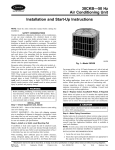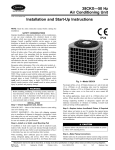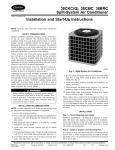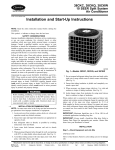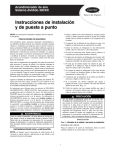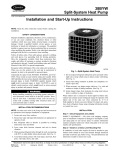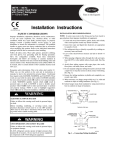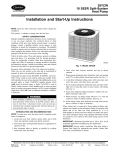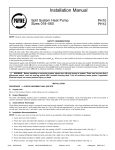Download Carrier 38CKC 50 Hz Instruction manual
Transcript
38 CKC—50 Hz Air Conditioning Unit Visit www.carrier.com Installation and Start-Up Instructions NOTE: Read the entire instruction manual before starting the installation. This symbol → indicates a change since the last issue. SAFETY CONSIDERATIONS Improper installation, adjustment, alteration, service, maintenance, or use can cause explosion, fire, electrical shock, or other conditions which may cause death, personal injury, or property damage. Consult a qualified installer, service agency, or your distributor or branch for information or assistance. The qualified installer or agency must use factory-authorized kits or accessories when modifying this product. Refer to the individual instructions packaged with the kits or accessories when installing. Follow all safety codes. Wear safety glasses, protective clothing, and work gloves. Use quenching cloth for brazing operations. Have fire extinguisher available. Read these instructions thoroughly and follow all warnings or cautions included in literature and attached to the unit. Consult local building codes and National Electrical Code (NEC) for special requirements. Recognize safety information. This is the safety-alert symbol . When you see this symbol on the unit and in instructions or manuals, be alert to the potential for personal injury. Understand the signal words DANGER, WARNING, and CAUTION. These words are used with the safety-alert symbol. DANGER identifies the most serious hazards which will result in severe personal injury or death. WARNING signifies hazards which could result in personal injury or death. CAUTION is used to identify unsafe practices which would result in minor personal injury or product and property damage. NOTE is used to highlight suggestions which will result in enhanced installation, reliability, or operation. Before installing, modifying, or servicing system, main electrical disconnect switch must be in the OFF position. There may be more than 1 disconnect switch. Lock out and tag switch with a suitable warning label. Electrical shock can cause personal injury or death. INTRODUCTION These are the Installation and Start-Up Instructions for the 38CKC—50 Hz Air Conditioning Unit. INSTALLATION Step 1—Check Equipment and Job Site UNPACK UNIT Move to final location. Remove carton, taking care not to damage unit. INSPECT EQUIPMENT File claim with shipping company prior to installation if shipment is damaged or incomplete. Locate unit-rating plate on unit service panel. (See Fig. 2.) It contains information needed to properly install unit. Check rating plate to be sure unit matches job specifications. A97005 Fig. 1—Model 38CKX Step 2—Install on a Solid, Level Mounting Pad If conditions or local codes require the unit be attached to pad, tie-down bolts should be used and fastened through knockouts provided in unit base pan. Refer to unit-mounting pattern in Fig. 2 to determine base-pan size and knockout-hole location. When installing, allow sufficient space for airflow clearance, wiring, refrigerant piping, and service. Allow 30-in. (762mm) clearance to service end of unit and 48 in. (1219mm) above unit. For proper airflow, a 6-in. (152mm) clearance on 1 side of unit and 12 in. (305mm) on all remaining sides must be maintained. Maintain a distance of 24 in. (610mm) between air conditioners. Position so water, snow, or ice from roof or eaves cannot fall directly on unit. On rooftop applications, locate unit 6 in. (152mm) above roof surface. Where possible, place unit above a load-bearing wall. Arrange supporting members to adequately support unit and minimize transmission of vibration to building. Consult local codes governing rooftop applications. Step 3—Replace Indoor AccuRater® Piston, if Required Check indoor coil piston to see if it matches the required piston shown on outdoor unit rating plate. If it does not match, replace indoor coil piston with piston shipped with the outdoor unit. The piston shipped with outdoor unit is correct for any approved indoor coil combination. Step 4—Make Piping Connections Outdoor units may be connected to indoor sections using accessory tubing package or field-supplied refrigerant grade tubing of correct size and condition. For tubing requirements beyond 50 ft (15.24m), or 20 ft vertical differential, consult Long-Line Application Guideline which is available at your local distributor. Manufacturer reserves the right to discontinue, or change at any time, specifications or designs without notice and without incurring obligations. Book 1 4 PC 101 Catalog No. 003-840 Printed in U.S.A. Form 38CKC-C2SI Pg 1 4-01 Replaces: 38CKC-C1SI Tab 3a 2a AIR IN AIR DISCHARGE AIR IN AIR IN AIR DISCHARGE NOTES: 1. Allow 30 in. (762 mm) clearance to service end of unit, 48 in. (1219 mm) above unit, 6 in. (152 mm) on one side, 12 in. (305 mm) on remaining side, and 24 in. (610 mm) between units for proper airflow. 2. Minimum outdoor operating ambient in cooling mode is 55° F (12.8° C), MAX. 125° F (51.7° C). 3. Dimensions in parentheses are in millimeters. 4. Series designation is the 13th position of the unit model number. AIR IN A AIR DISCHARGE RATING LABEL E B FIELD POWER SUPPLY CONN 7/8 IN. DIA (22.22) HOLE WITH 1 1/8 IN. DIA (28.57) KNOCKOUT AND 1 3/8 IN. DIA (34.92) KNOCKOUT G FIELD CONTROL SUPPLY CONN 7/8 IN. DIA (22.22) HOLE F DIA C D 3/8 IN. DIA (9.53) LIQUID LINE CONN SUCTION LINE CONN A97003 UNITSIZE 018 024 036 048 060 A/B In. 18 22-1/2 22-1/2 30 30 C mm 457.2 571.5 571.5 762.0 762.0 In. 3 3-11/16 3-11/16 6-1/2 6-1/2 D mm 76.2 93.6 93.6 165.1 165.1 In. 15 18-1/8 18-1/8 23-1/2 23-1/2 E mm 381.0 460.4 460.4 596.9 596.9 In. 10-3/16 14-3/8 14-3/8 20 20 F mm 258.8 365.1 365.1 508.0 508.0 In. 5/8 5/8 3/4 7/8 7/8 G mm 15.9 15.9 19.1 22.2 22.2 In. 25-15/16 21-15/16 33-15/16 27-15/16 39-15/16 mm 658.8 557.2 862.0 709.6 1014.4 Fig. 2—Unit Reference Drawing NOTE: In some cases, noise in the living area has been traced to gas pulsations from improper installation of equipment. 9. When necessary, use hanger straps which are 1 in. (25mm) wide and conform to shape of tubing insulation. (See Fig. 3.) 10. Isolate hanger straps from insulation by using metal sleeves bent to conform to shape of insulation. If refrigerant tubes or indoor coil is exposed to atmospheric conditions, it must be evacuated to 500 microns to eliminate contamination and moisture in the system. INSTALLATION RECOMMENDATIONS 1. Locate unit away from windows. 2. Ensure that vapor- and liquid-tube diameters are appropriate to capacity of unit. (See Table 1.) 3. Run refrigerant tubes as directly as possible by avoiding unnecessary turns and bends. To prevent compressor damage DO NOT bury more than 36 in. (914mm) of refrigerant tubing. If ANY tubing is buried, provide 6 in. (152mm) vertical rise at service valve. 4. Leave some slack between structure and unit to absorb vibration. 5. When passing refrigerant tubes through the wall, seal opening with RTV or other pliable silicon-based caulk. (See Fig. 3.) OUTDOOR UNITS CONNECTED TO FACTORY-APPROVED INDOOR UNITS Outdoor unit contains correct system refrigerant charge for operation with indoor unit of same size when connected by 15 ft (4.55m) of field-supplied or factory-accessory tubing. Check refrigerant charge for maximum efficiency. REFRIGERANT TUBING Connect tubing to fittings on outdoor unit vapor and liquid service valves. (See Fig. 2.) 6. Avoid direct tubing contact with water pipes, duct work, floor joists, wall studs, floors, and walls. 7. Do not suspend refrigerant tubing from joists and studs with a rigid wire or strap that comes in direct contact with tubing. (See Fig. 3.) 8. Ensure that tubing insulation is pliable and completely surrounds vapor tube. 2 Table 1—Refrigerant Connections and Recommended Liquid and Vapor Tube Diameters LIQUID Connection Dia In. mm 3/8 9.53 3/8 9.53 3/8 9.53 3/8 9.53 UNITSIZE 018/024 036 048 060 VAPOR Tube Dia In. 3/8 3/8 3/8 3/8 mm 9.53 9.53 9.53 9.53 Connection Dia In. mm 5/8 15.88 3/4 19.05 7/8 22.23 7/8 22.23 Tube Dia In. 5/8 3/4 7/8 1-1/8 mm 15.88 19.05 22.23 28.58 NOTES: 1. Tube diameters are for lengths up to 50 ft (15.24m). For tube sets over 50 ft (15.24m), consult Long-Line Application Guideline. 2. Do not apply capillary tube indoor coils to these units. Step 5—Make Electrical Connections Be sure field wiring complies with local and national fire, safety, and electrical codes, and voltage to system is within limits shown on unit rating plate. Contact local power company for correction of improper voltage. See unit rating plate for recommended circuit protection device. Relieve pressure and recover all refrigerant before system repair or final unit disposal to avoid personal injury or death. Use all service ports and open all flow-control devices, including solenoid valves. NOTE: Operation of unit on improper line voltage constitutes abuse and could affect unit reliability. See unit rating plate. Do not install unit in system where voltage or phase imbalance may fluctuate above or below permissible limits. To prevent damage to unit or service valves observe the following: • Use a brazing shield. • Wrap service valves with wet cloth or use a heat sink material. NOTE: Use copper wire only between disconnect switch and unit. NOTE: Install branch circuit disconnect per local codes of adequate size to handle unit starting current. Locate disconnect within sight from and readily accessible from unit per local codes. SWEAT CONNECTION Use refrigerant grade tubing. Service valves are closed from factory and ready for brazing. After wrapping service valve with a wet cloth, braze sweat connections using industry accepted methods and materials. Consult local code requirements. Refrigerant tubing and indoor coil are now ready for leak testing. This check should include all field and factory joints. To avoid personal injury or death, do not supply power to unit with compressor terminal box cover removed. NOTE: Avoid contact between tubing and structure. OUTDOOR WALL The unit cabinet must have an uninterrupted or unbroken ground to minimize personal injury if an electrical fault should occur. The ground may consist of electrical wire or metal conduit when installed in accordance with existing electrical codes. Failure to follow this warning can result in an electric shock, fire, or death. INDOOR WALL CAULK LIQUID TUBE ROUTE GROUND AND POWER WIRES Remove access panel and control box cover to gain access to unit wiring. Extend wires from disconnect through power wiring hole provided and into unit control box. (See Fig. 2.) Size wires per local codes, but not smaller than minimum wire size shown on unit rating plate. VAPOR TUBE INSULATION THROUGH THE WALL JOIST HANGER STRAP (AROUND VAPOR TUBE ONLY) CONNECT GROUND AND POWER WIRES Connect ground wire to ground connection in control box for safety. Connect power wiring to contactor as shown in Fig. 4. INSULATION VAPOR TUBE NOTE: Use No. 18 AWG (American Wire Gage) color-coded, insulated (35° C minimum) wire. If thermostat is located more than 100 ft (30.5m) from unit as measured along the control voltage wires, use No. 16 AWG color-coded wires to avoid excessive voltage drop. 1″ MIN (25 mm) CONNECT CONTROL WIRING LIQUID TUBE SUSPENSION Route 24-v control wires through control wiring grommet and connect to brown and blue pigtails supplied in unit splice box. (See Fig. 5.) Use furnace transformer, fan-coil transformer, or accessory transformer for control power, 24-v/40-va minimum. A94330 Fig. 3—Piping Installation 3 erant flow (back seated). Replace caps finger-tight and tighten additional 1/6 turn with wrench. DISCONNECT PER IEC AND/OR LOCAL CODES 3. Close electrical disconnects to energize system. FIELD POWER WIRING CONTACTOR L1 L2/N L3 4. Set room thermostat at desired temperature. Be sure set point is below indoor ambient temperature. L1 N FOR 1-PHASE ONLY 3-PHASE ONLY PE 5. Set room thermostat to COOL and fan to ON or AUTO mode, as desired. Operate unit for 15 minutes. Check system refrigerant charge. L2/N 6. Factory charge is shown on unit rating plate. Adjust charge by following procedure shown on charging tables located on unit. L3 PE → GROUND LUG A96650 Fig. 4—Line Power Connections NOTE: Use of available 24-v accessories may exceed the minimum 40-va power requirement. Determine total transformer loading and increase the transformer capacity or split the load with accessory transformer as required. • 3-phase scroll compressors are rotation sensitive. • A flashing LED on phase monitor indicates reverse rotation. (See Fig. 6 and Table 3.) • This will not allow contactor to be energized. • Disconnect power to unit and interchange 2 field wiring leads on unit contactor. → SEQUENCE OF OPERATION Turn on power to indoor and outdoor units. Transformer is energized. Step 6—Compressor Crankcase Heat On a call for cooling, thermostat makes circuits R-Y and R-G. On three phase models with scroll compressors, the units are equipped with a phase monitor to detect if the incoming power is correctly phased for compressor operation. (See Fig. 5 and Table 2.)If the phasing is correct, circuit R-Y energizes contactor, starting outdoor fan motor and compressor circuit. R-G energizes indoor unit blower relay, starting indoor blower motor on high speed. When equipped with a crankcase heater, energize heater a minimum of 24 hr before starting unit. To energize heater only, set thermostat to OFF and close electrical disconnect to outdoor unit. A crankcase heater is required if the refrigerant tubing is longer than 50 ft (15.24m). Step 7—Install Electrical Accessories, If Any Refer to the individual instructions packaged with the kit or accessory when installing. Step 8—Start-Up and Check Charge To prevent compressor damage or personal injury, observe the following: • Do not overcharge system with refrigerant. • Do not operate unit in a vacuum or at negative pressure. • Do not disable low-pressure switch. In scroll compressor applications: • Dome temperatures may be hot. To prevent personal injury wear safety glasses, protective clothing, and gloves when handling refrigerant and observe the following: • Back seating service valves are not equipped with Schrader valves. Fully back seat (counter clockwise) valve stem before removing gage port cap. • Front seating service valves are equipped with Schrader valves. A00010 Fig. 5—Phase Monitor Control Table 2—Phase Monitor LED Indicators LED OFF FLASHING ON Do not vent refrigerant to atmosphere. Recover during system repair or final unit disposal. STATUS No call for compressor operation Reversed phase Normal 1. Fully back seat (open) liquid and vapor tube service valves. NOTE: If the phasing is incorrect, the contactor will not be energized. To correct the phasing, interchange any two of the three power connections on the field side. 2. Unit is shipped with valve stem(s) front seated and caps installed. Replace stem caps after system is opened to refrig- When thermostat is satisfied, its contacts open, de-energizing contactor and blower relay. Compressor and motors stop. 4 THERMOSTAT THERMOSTAT FURNACE R R R M G MOTOR POWER SUPPLY C TRANS IFR C Y COOLING ONLY G G Y Y W W/ W1 ONE STAGE COOLING / GAS HEATING THERMOSTAT FAN COIL THERMOSTAT INDOOR UNIT R R R R C G G Y W C C C G G Y Y Y W2 W W ONE STAGE COOLING / ELECTRIC HEAT LLS C ONE STAGE COOLING / HEATING ACCESSORY LIQUID LINE SOLENOID NOTES: 1. Wiring must conform to local codes. 2. LLS required on some units. See specific unit instructions. 3. Transformer required is 24-v, 40-va minimum. A 60-va or external power source may be necessary when installing accessories. 4. When installing electronic thermostat, connect transformer common to thermostat C. LEGEND: C LLS M – COMPRESSOR CONTACTOR – LIQUID LINE SOLENOID – INDOOR FAN MOTOR TRANS – TRANSFORMER IFR – INDOOR FAN RELAY A94331 Fig. 6—24-v Control Circuit Connections Leave User’s Manual with owner. Explain system operation and periodic maintenance requirements outlined in manual. Frequency of maintenance may vary depending on geographic areas, such as coastal applications which require more frequent maintenance. If indoor unit is equipped with an off-delay circuit, the indoor blower can run up to an additional 120 sec to increase system efficiency. CARE AND MAINTENANCE For continued high performance and to minimize possible equipment failure, periodic maintenance must be performed on this equipment. 5 6 7 Copyright 2001 CARRIER Corp. • 7310 W. Morris St. • Indianapolis, IN 46231 38ckcc2si Manufacturer reserves the right to discontinue, or change at any time, specifications or designs without notice and without incurring obligations. Book 1 4 PC 101 Catalog No. 003-840 Printed in U.S.A. Form 38CKC-C2SI Pg 8 4-01 Replaces: 38CKC-C1SI Tab 3a 2a









